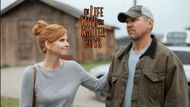My Life with the Walter Boys could have been just another YA show defined by a single choice: one girl caught between two boys. Instead, season 2 leans into the chaos of growing up, where grief, ambition, and messy family bonds weigh as heavily as romance.
Jackie’s return to Silver Falls in the second season of My Life with the Walter Boys is about facing the trauma she has been avoiding, colliding with Cole and Alex in ways that expose who they really are, and letting the rest of the Walter clan step into the light.
This season refuses to flatten itself into Team Cole versus Team Alex, pushing instead for a story that feels like life: crowded, complicated, and unwilling to fit inside the neat borders of a love triangle.

Jackie’s grief is the real protagonist
Season 2 of My Life with the Walter Boys makes Jackie’s pain the real core of the story. After trying to reinvent herself in New York, she comes back to Silver Falls carrying the same weight she thought she had left behind. In the teaser, Nikki Rodriguez admits,
“I spent all summer spiraling about how – and why – I left.”
It's the confession of someone who tried to outrun loss only to find it waiting at every turn.
When she arrives, Katherine meets her with an embrace and tells her,
“You do belong, Jackie. With us.”
The moment is more than reassurance. It's a demand that she stop avoiding the reality of her grief and face it within the family that has taken her in.
What gives Jackie's arc such force in the second season of My Life with the Walter Boys is the permission the show gives her to falter. She lashes out, hides, and reaches for comfort in the wrong places, and none of it resolves neatly. The series turns this chaos into texture rather than a flaw.
As the cast explained,
“Tragedy comes in many shapes, with many layers. Just growing up can feel like one long, tragic experience.”
That perspective transforms Jackie’s grief into something larger than her personal loss, thus becoming the lens through which My Life with the Walter Boys shows adolescence itself as a form of catastrophe. In doing so, it raises the series far above the level of a simple teen romance.

Cole learning he cannot fix everything
Cole enters the second season of My Life with the Walter Boys stripped of the golden image that once defined him. The quarterback's dreams are gone, the easy confidence has cracked, and what remains is a boy who keeps trying to stitch himself back together by holding others up.
Coaching becomes his outlet, a way to channel the fire he once poured into the field. On the surface, it looks like redemption, but it is more like a reflection. Every play he calls for his team is also a test of who he might become without the identity that once defined him.
Noah LaLonde explained that the release comes when Jackie finally speaks the words both of them had avoided:
“There is such a payoff in getting to say those things out loud.”

The admission forces Cole to stop mistaking silence for control. For the first time, he faces the possibility that his instinct to fix and protect cannot undo the wreckage he carries.
What makes this arc so striking is that it is not about victory but surrender. Cole learns that he cannot bend the world into shape, cannot rescue every heart, cannot shoulder the Walters like a mythic hero. The series dares to let its most magnetic figure stumble and bruise, to show that coming of age sometimes means accepting limits instead of conquering them. The weight of that lesson gives Cole’s story a rawness that keeps My Life with Walter Boys from drifting into the safe rhythms of a typical teen romance.

Alex and the rodeo reinvention
Alex returns to Silver Falls like he spent the summer auditioning for a role he was never meant to play. The boy who once buried himself in books and video games suddenly abandons it all for rodeo dust and a swagger that feels borrowed.
Ashby Gentry teased that season 2 is
“more intense… it’s really about them trying new things,”
and Alex takes that literally, turning himself into a version of confidence that looks manufactured.
The issue is that the glow-up feels less like a breakthrough and more like a cosplay of a bad boy. Instead of leaning into the vulnerability that made him distinct, Alex postures. He trades authenticity for performance, as if a bronc ride could erase heartbreak or prove he belongs in the same league as Cole. It's an arc written as reinvention but performed as overcompensation.
The result is not the compelling transformation the writers may have envisioned. It's a character trying to prove he's tougher, louder, and edgier than he actually is, while shedding the parts of himself that once had substance. Out of character, Alex becomes less magnetic and more pathetic, a boy scrambling to wear someone else’s skin rather than grow into his own.
And yet this awkward attempt at bravado has an unintended upside. Because Alex’s transformation feels hollow yet fitting in the series, the spotlight shifts naturally to others around him.
Characters like Kiley get more space to breathe, with their own messy, interesting storylines that are not tethered to the triangle. Alex’s cosplay of toughness becomes almost useful, creating negative space in which the rest of the Walter universe can shine.

Every Walter boy deserves the sun
One of the smartest choices My Life with the Walter Boys makes in its second season is refusing to orbit entirely around Jackie, Cole, and Alex. Showrunner Melanie Halsall explained her commitment clearly:
“We’ve got a lot of characters on our show, and I think they should all get their place in the sun.”
That vision reshapes the series into more of an ensemble and gives every Walter and every friend attached to them room to matter.
You can see the effect most clearly in Kiley, who evolves from a background crush to a focal point with her own messy, complicated romance. Her connection with Dylan and the tensions that ripple through it are allowed to play out with the same gravity usually reserved for the leads. Instead of being reduced to a plot device for Alex, she becomes someone with her own desires, contradictions, and agency. And that is very welcome.
That same generosity extends to the rest of the Walter clan. Nathan’s antics, Isaac’s small victories, and the parents’ struggles all fill the frame with life that makes Silver Falls feel lived-in rather than staged.
This distribution of attention turns the series into a story that feels communal rather than individual, proving that every Walter boy and every person orbiting their world has a reason to be seen.

From barns to vineyards: family drama as expansion
If My Life with the Walter Boys season 1 was about Jackie finding her footing inside the Walter household, season 2 makes it clear that the family itself can carry just as much dramatic weight as the central triangle. The story widens its frame to follow George and Katherine into crises that reshape the farm and pull the younger Walters into unexpected responsibilities.
The second season of My Life with the Walter Boys plants its first big shift in the ashes of a barn fire. What could have been background noise in another YA series becomes a turning point, a symbol of how fragile the family’s livelihood is. George responds with the kind of impulse that defines him, throwing energy into a half-baked vineyard project that feels both hopeful and reckless.
Katherine’s own struggles as a veterinarian add another layer, showing that even the adults in this world are improvising their way through pressure and disappointment.
The finale of My Life with the Walter Boys Season 2 doubles down by dropping the heaviest blow yet: George collapsing as an ambulance rushes him away. The moment works as both a cliffhanger and a reminder.
My Life with the Walter Boys is about young hearts colliding and also about the ground they stand on, a home that can shake or even fall apart. By giving real space to barns, vineyards, health scares, and work stress, the show brings an intergenerational chaos that most teen dramas ignore.
It lets Walter's parents and their world matter in ways the original book never attempted, and the result is a fuller, messier portrait of a family that refuses to be a backdrop.

My Life with the Walter Boys and the plan to grow old with the characters
One of the boldest signals that My Life with the Walter Boys wants to break the YA mold comes from its own showrunner. Melanie Halsall has been upfront that she sees the series as a long game, not a quick adaptation that burns through Ali Novak’s book and fades away.
“I’m fascinated by these characters and these stories in this world, and I would love to keep telling these stories for as long as people keep watching,” she explained.
She even teased the possibility that
“we might be seeing our characters get older and older as we go ahead.”
That promise changes how season 2 of My Life with the Walter Boys feels. Every subplot, from the barn fire to Cole’s coaching, Jackie’s grief, and Alex’s hollow rodeo swagger, reads not just as a chapter but as setup for something bigger.
The writers are planting seeds that can grow as the actors themselves age, letting the show follow them into college, into adulthood, and into the kind of transformations most YA stories cut away from.
The love triangle will remain part of the engine, Halsall admitted, but the plan to keep the characters moving through life gives the story room to outlive the clichés. Instead of freezing its leads in a perpetual high school bubble, My Life with the Walter Boys aims to treat time as a collaborator.
If My Life with the Walter Boys lasts, audiences will watch Jackie and the Walters stumble into the next versions of themselves in real time, and that kind of ambition is rare in the genre, and it makes the show feel less like an adaptation of a single book and more like a saga in motion.

Why My Life with the Walter Boys matters in the YA landscape
YA dramas often get trapped in their own triangles, spinning endlessly around who the protagonist will kiss next. The Summer I Turned Pretty is the clearest recent example of that, a show that lives or dies on the answer to one question.
My Life with the Walter Boys chooses another path. The romance remains central, but the story pulses with grief, family chaos, personal reinvention, and even failure. That balance gives it more texture than most adaptations dare to try.

The difference is not subtle. While The Summer I Turned Pretty recycles the push and pull of Jeremiah and Conrad until the debate drowns the rest of the narrative, My Life with the Walter Boys deliberately opens space for barns burning, parents collapsing, and side characters stepping into their own arcs.
Kiley and Dylan’s messy storyline matters. Katherine’s career matters. Cole’s surrender matters. Even Alex’s hollow cosplay of a bad boy has value, because it clears a lane for others to shine.
This is why My Life with the Walter Boys matters in the YA field. It understands that growing up cannot be reduced to a single choice of partner. It's about grief that lingers, families that wobble, and ambitions that sometimes fall flat. It's about characters stumbling toward adulthood in ways that are uneven, flawed, and unforgettable.
Season 2 of My Life with the Walter Boys confirms that this is not just a romance with scenic mountains in the background; it's a series willing to get messy, to sprawl, and to grow with its audience. And that willingness to stretch beyond the triangle is what gives it the weight to last.
